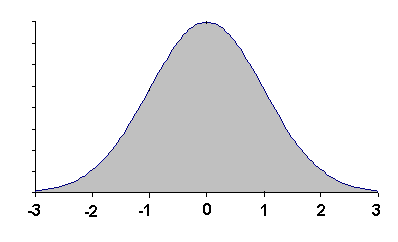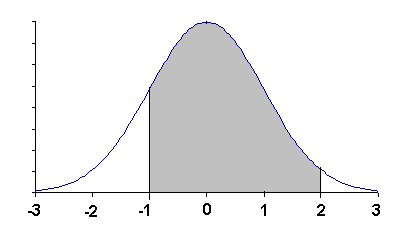

Solution: The value -1.00 on the x-axis of the normal curve is called a z-value. Use the first table in the normal table for negative numbers. Look in the -1.0 row and the .00 column to find .1587. The answer is: 0.1587.

Solution: Look the z-value 2.00 up in the second table for positive numbers, also in the normal table. Look in the 2.0 row and the 0.00 column to find .9772. The answer is 0.9772.

Solution: (-3.00, 2.00] can be written as the set-theoretic difference
(-∞, 3.00] - (-∞, -3.00]. Look up these bins in
the normal table:
(-∞, 3.00] has the proportion 0.9987
and (-∞, -3.00] has the proportion 0.0013. Therefore
the proportion of observations in
(-3.00, 2.00] =
(-∞, 3.00] - (-∞, -3.00] is
0.9987 - 0.0013 = 0.9974.
Note: is does not matter whether we ask for the proportion of observations in (-3.00, 2.00], (-3.00, 2.00), [-3.00, 2.00), or [-3.00, 2.00]. They contain the same proportion of observations because the normal curve is an idealized continuous histogram where the the proportion of observations at a single point is always zero.

Solution: (0.50, 1.50] = (-∞, 1.50] - (-∞, 0.50]. The the normal table gives the proportion of observations as 0.9332 - 0.6915 = 0.2417 = 24%.
-
z = (x - x) / SD+ = (40 - 50) / 10 = -1
-
z = (x - x) / SD+ = (70 - 50) / 10 = 2
